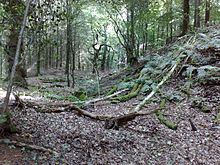| Battle of Peonnum | |||||||
|---|---|---|---|---|---|---|---|
 Remains of the reconditioned Roman Fort north of Penselwood known as Kenwalch's Castle showing residual banks and ditches | |||||||
| |||||||
| Belligerents | |||||||
| West Saxons | Britons | ||||||
| Commanders and leaders | |||||||
| Cenwalh | |||||||
The Battle of Peonnum was fought about AD 660 between the West Saxons under Cenwalh and the Britons of what is now Somerset in England. It was a decisive victory for the Saxons, who gained control of Somerset as far west as the River Parrett. The location of the battle is uncertain.
Saxon conquest
The border between the West Saxons and the Britons of Somerset had been set at the Wansdyke along the ridge of the Mendip Hills following the Battle of Deorham and the Saxon occupation of Bath in 577. Then, in 652, Cenwalh broke through at the Battle of Bradford on Avon.
Relief for the Britons came when Cenwalh was exiled to East Anglia after a squabble with Penda of Mercia. Some time after his return he renewed the attack on the British tribes and in 658 his army met the Britons for a climactic battle at Peonnum. The Saxons were victorious, and Cenwalh advanced west through the Polden Hills to the River Parrett, annexing eastern and central Somerset. The territory gained was modest in size; Geoffrey Ashe suggests that Cenwalh's ultimate goal may have been gaining control over the valuable Glastonbury Abbey within it.
The border remained at the Parrett until 681–685, when Centwine of Wessex defeated King Cadwaladr of Gwynedd and his local allies, allowing them to occupy the rest of Somerset west and north to the Bristol Channel. West Saxon rule was consolidated and extended into Devon by King Ina.
Location
The battle is said to have happened æt peonnum, which means "at the penns". Penn is the Brittonic Celtic word for "head" or "top", widely used for "hill" or "peak". An element 'Pen' in modern place-names in this area is found in Penselwood (Pen Selwood), near Wincanton which is called Penna in the Domesday Book, Pinhoe or Pen Beacon in Devon, and Penn (near Yeovil). One of the highest points of the Mendip Hills is named Pen Hill.
See also
Notes
- "Allowing again for the slight chronological inaccuracy of the Chronicle across these years, this event may he dated c. 660. The annal implies that by this date Cenwealh dominated the Saxons of Wiltshire and beyond." Kirby, D. B. The Earliest English Kings Routledge; Revised Edition (30 April 2000) ISBN 978-0-415-24211-0 p.47
- ^ Major, p. 44.
- Bede, Ecclesiastical History of the English People, Book III, chapter 7.
- Ashe, p. 279
- "War Tourist". British Battles. Retrieved 27 March 2010.
- The Victoria History of the County of Somerset, Vol 1 (1906)
- "The Head of Annwfn". The Mabinogion and the Mabinogi. Retrieved 27 March 2010.
- Major, p. 45
- Yorke, p. 53
- Cooper, David: Badon and the Early Wars for Wessex, circa 500 to 710 (2018: Pen & Sword Books) pp. 200-206
References
- Ashe, Geoffrey, From Caesar to Arthur, University of Michigan, 1960.
- Major, Albany F., Early Wars of Wessex, Cassell Press, 1978
- Yorke, Barbara Wessex in the Early Middle Ages Leicester University Press (31 Aug 1995) ISBN 978-0-7185-1856-1
Categories: